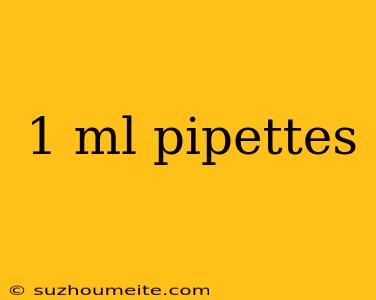1 mL Pipettes: Accurate Liquid Handling for Laboratory Applications
Introduction
In laboratory settings, accurate liquid handling is crucial for obtaining reliable results. One of the essential tools for achieving this accuracy is the 1 mL pipette. In this article, we will discuss the importance of 1 mL pipettes, their features, and applications in various laboratory settings.
What is a 1 mL Pipette?
A 1 mL pipette is a laboratory instrument used to measure and transfer small volumes of liquids with high precision. It is designed to handle volumes as small as 1 mL, making it an essential tool for laboratories that require accurate measurements.
Features of 1 mL Pipettes
1 mL pipettes are designed with several features that make them ideal for laboratory use:
- Accuracy: 1 mL pipettes are designed to deliver accurate volumes, often with an accuracy of ±1%.
- Precision: These pipettes are designed to minimize variability in volume delivery, ensuring consistent results.
- Ergonomic Design: 1 mL pipettes are designed to fit comfortably in the hand, reducing fatigue and improving precision.
- Easy Calibration: Many 1 mL pipettes are designed for easy calibration, ensuring that the instrument remains accurate over time.
Applications of 1 mL Pipettes
1 mL pipettes are used in a variety of laboratory settings, including:
- Molecular Biology: 1 mL pipettes are used to transfer small volumes of DNA, RNA, and other biological molecules.
- Chemistry: These pipettes are used to measure and mix small volumes of chemicals, ensuring accurate reactions and results.
- Pharmaceutical Research: 1 mL pipettes are used to measure and mix small volumes of active pharmaceutical ingredients.
- Quality Control: These pipettes are used to measure and test small volumes of substances in quality control laboratories.
Tips for Using 1 mL Pipettes
To ensure accurate results when using a 1 mL pipette, follow these tips:
- Handle with Care: 1 mL pipettes are precision instruments and should be handled with care to avoid damage.
- Calibrate Regularly: Regular calibration ensures that the pipette remains accurate over time.
- Use Correct Technique: Use the correct pipetting technique to ensure accurate volume delivery.
Conclusion
In conclusion, 1 mL pipettes are essential tools for laboratory applications that require accurate liquid handling. With their high accuracy, precision, and ergonomic design, these pipettes are ideal for a variety of laboratory settings. By following proper techniques and handling the instrument with care, researchers can ensure accurate results and reliable data.
